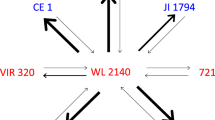Summary
The low number of useful S-alleles in several species and varieties of cruciferous crops (Brassica, Raphanus) may hamper the set-up of a practical programme of hybrid breeding based on sporophytic one-locus incompatibility. Few S-alleles may considerably reduce the number of reciprocally compatible crosses and therefore restrict the possibilities of selection for combining ability and for suitable S-alleles. This problem is discussed in this article. General formulae are derived for calculating the maximum number of reciprocally compatible cross combinations for three types of crosses (singles, three-ways and doubles), four types of S-allele interactions (I, II, III, IV: table 1), different numbers of S-homozygotes (1,2.....n) and different numbers of genotypes per S-homozygote (equal: x; unequal: x1....k....xn).
The following conclusions could be drawn. Selecting several lines per S-homozygote can to a certain degree compensate for a low number of S-alleles. An equal number of lines per S-homozygote in general is most favourable. If unequal numbers of lines per homozygote are obtained, then—with a constant total number of lines—the number of reciprocally compatible crosses is dependent on the variation of the number of lines and for certain inheritance types also on the distribution of the lines in relation to the nature of the S-alleles (recessivity-dominance). It is argued that a genetically very broadly based starting material is indispensable for a successful hybrid breeding programme.
Similar content being viewed by others
References
Bateman, A. J., 1955. Self-incompatibility systems in Angiosperms. I. Theory. Heredity 6: 285–310.
Bateman, A. J., 1955. Self-incompatibility systems in Angiosperms. III. Cruciferae. Heredity 9: 53–68.
Haruta, T., 1962. Studies on the genetics of self-and cross incompatibility in cruciferous vegetables. Research Bull. 2: 169 pp.
Nishi, S., 1967. F1 seed production in Japan. Proc. XVIIth Internat. Hort. Congr. 3: 231–257.
Author information
Authors and Affiliations
Rights and permissions
About this article
Cite this article
Hermsen, J.G.T. Frequencies of reciprocally compatible single, three-way and double crosses as determined by the number of S-homozygotes, the number of lines per S-homozygote and the types of inheritance of incompatibility in cruciferous crops. Euphytica 18, 170–177 (1969). https://doi.org/10.1007/BF00035688
Received:
Issue Date:
DOI: https://doi.org/10.1007/BF00035688




